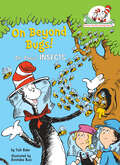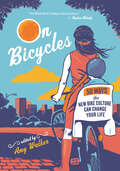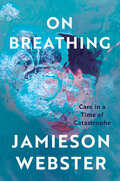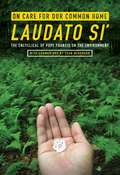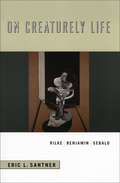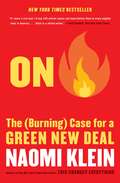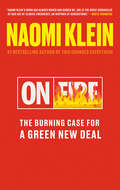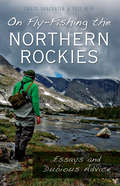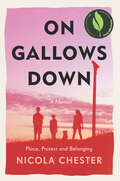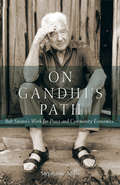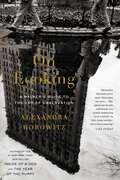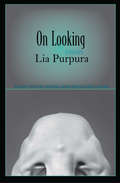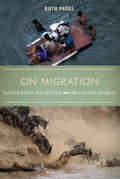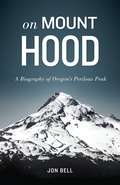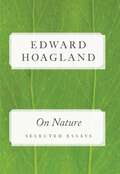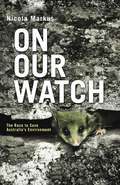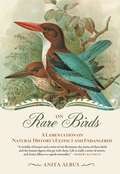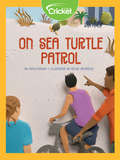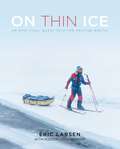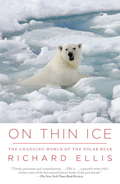- Table View
- List View
On Beyond Bugs! All About Insects: All About Insects (The Cat in the Hat's Learning Library)
by Tish RabeLaugh and learn with fun facts about butterflies, ants, bees, and more—all told in Dr. Seuss&’s beloved rhyming style and starring The Cat in the Hat! &“I&’m the Cat in the Hat, and I&’m glad that I found you. Right now, if you look, you&’ll see insects around you.&” The Cat in the Hat&’s Learning Library series combines beloved characters, engaging rhymes, and Seussian illustrations to introduce children to non-fiction topics from the real world! In this journey into the world of insects, readers will learn:• how ants can lift things ten times their weight• how bees communicate by dancing• why flies buzz• and much more! Perfect for story time and for the youngest readers, On Beyond Bugs! also includes an index, glossary, and suggestions for further learning. Look for more books in the Cat in the Hat&’s Learning Library series!Cows Can Moo! Can You? All About FarmsHark! A Shark! All About SharksIf I Ran the Dog Show: All About DogsOh Say Can You Say Di-no-saur? All About DinosaursOne Vote Two Votes I Vote You VoteThere&’s No Place Like Space: All About Our Solar SystemWho Hatches the Egg? All About EggsWhy Oh Why Are Deserts Dry? All About DesertsWish for a Fish: All About Sea Creatures
On Bicycles: 50 Ways the New Bike Culture Can Change Your Life
by Amy WalkerOnce the quaint province of European cities such as Amsterdam, daily cycling is currently exploding in North American cities. People ride folding bikes to the train, slip through traf?c on tricked-out ?xed-gears, and carry children and groceries on their utility bikes. Commuters are giving up their cars Monday through Friday, bike lanes and bike parking are sprouting up all over, and Talking Head David Byrne has designed arty bike racks for various New York City neighborhoods. It’s healthy for riders and clean for the environment, but is it fun? Amy Walker, who has been at the forefront of the urban cycling trend, knows that the answer is yes. She presents stories by a diverse group of cycling enthusiasts and activists that, accompanied by the illustrations of bike culture artist Matt Fleming, show readers why. They say you never forget how to ride a bike; this collection helps us remember why we ride.
On Breathing: Care in a Time of Catastrophe
by Jamieson WebsterA gorgeous, expansive piece of narrative non-fiction about care, dependence, and what it means to breathe in an age of environmental catastropheA few moments after birth we begin to use our lungs for the first time. From then on, we must continue breathing for as long as we are alive. And although this mostly happens unconsciously, in a society plagued by anxiety, climate change, environmental racism, and illness, there are more and more instances that &“teach us about the privilege that is breathing.&” Why do we so easily forget the air that we breathe in common? What does it mean to breathe when the environment that sustains life now threatens it? And how can life continue to flourish under conditions that are increasingly toxic? To approach these questions, Jamieson Webster draws on psychoanalytic theory and reflects on her own experiences as an asthmatic teenager, a deep-sea diver, a palliative psychologist during COVID, a psychoanalyst attentive to the somatic, and a new mother. The result is a compassionate and timely exploration of air and breathing as a way to undo the pervasive myth of the individual by considering our dependence on invisible systems, on one another, and the way we have violently neglected this important aspect of life.
On Care for Our Common Home Laudato Si': The Encyclical of Pope Francis on the Environment (Ecology And Justice)
by Pope Francis Sean McDonaghLaudato Si', Pope Francis's historic encyclical on the environment, was issued in 2015. As the first encyclical devoted entirely to the environment and related social justice issues, it represented a watershed in the church's engagement with such urgent challenges as climate change, environmental degradation, and the fate of the poor. This volume joins the full text of Laudato Si' with reflections by Sean McDonagh, one of the foremost Catholic proponents of ecological awareness. Aside from reviewing the history of Catholic teaching and the environment, he elaborates on several of the specific themes in the encyclical--climate change, biodiversity, water scarcity, the threats to the ocean, and the crisis of food. He concludes with prescriptions about what must be done to turn the pope's vision into a program of effective action. Each of us has a role to play. As Pope Francis observes, "All it takes is one good person to restore hope."
On Creaturely Life: Rilke, Benjamin, Sebald
by Eric L. SanterIn his Duino Elegies, Rainer Maria Rilke suggests that animals enjoy direct access to a realm of being—the open—concealed from humans by the workings of consciousness and self-consciousness. In his own reading of Rilke, Martin Heidegger reclaims the open as the proper domain of human existence but suggests that human life remains haunted by vestiges of an animal-like relation to its surroundings. Walter Benjamin, in turn, was to show that such vestiges—what Eric Santner calls the creaturely—have a biopolitical aspect: they are linked to the processes that inscribe life in the realm of power and authority. Santner traces this theme of creaturely life from its poetic and philosophical beginnings in the first half of the twentieth century to the writings of the enigmatic German novelist W. G. Sebald. Sebald’s entire oeuvre, Santner argues, can be seen as an archive of creaturely life. For Sebald, the work on such an archive was inseparable from his understanding of what it means to engage ethically with another person’s history and pain, an engagement that transforms us from indifferent individuals into neighbors. An indispensable book for students of Sebald, On Creaturely Life is also a significant contribution to critical theory.
On Fire: The (Burning) Case for a Green New Deal
by Naomi Klein#1 New York Times and internationally bestselling author Naomi Klein makes the case for a Green New Deal in this &“keenly argued, well-researched, and impassioned&” manifesto (The Washington Post).An instant bestseller, On Fire shows Klein at her most prophetic and philosophical, investigating the climate crisis not only as a profound political challenge but also as a spiritual and imaginative one. Delving into topics ranging from the clash between ecological time and our culture of &“perpetual now,&” to the soaring history of humans changing and evolving rapidly in the face of grave threats, to rising white supremacy and fortressed borders as a form of &“climate barbarism,&” this is a rousing call to action for a planet on the brink. An expansive, far-ranging exploration that sees the battle for a greener world as indistinguishable from the fight for our lives, On Fire captures the burning urgency of the climate crisis, as well as the fiery energy of a rising political movement demanding a catalytic Green New Deal. &“Naomi Klein&’s work has always moved and guided me. She is the great chronicler of our age of climate emergency, an inspirer of generations.&” —Greta Thunberg, climate activist "If I were a rich man, I&’d buy 245 million copies of Naomi Klein&’s 'On Fire' and hand-deliver them to every eligible voter in America…Klein is a skilled writer." —Jeff Goodell, The New York Times
On Fire: The Burning Case for a Green New Deal
by Naomi KleinA MUST-READ book. Naomi Klein pairs a decade of her powerful writing on our acute environmental decline with new material on the staggeringly high stakes of what we choose to do next; and inspiringly offers here a politically viable, just, sustainable path forward.For more than twenty years, Naomi Klein has been the foremost chronicler of the economic war waged on both people and planet--and the champion of a sweeping environmental agenda with stability and justice at its center. In lucid dispatches from the frontlines--from the ghostly Great Barrier Reef, to the annual smoke-choked skies of the Pacific Northwest, to post-hurricane Puerto Rico, to a Vatican attempting an unprecedented "ecological conversion"--she has penned surging, indispensable lectures and essays for a wide public, with prescient, clarifying information about the future that awaits us and our children if we stick our heads in the sand. They show Klein at her most thoughtful, tracing the evolution of the climate crisis as the key issue of our time, not only as an immediate political challenge but as a spiritual and imaginative one too. Delving into topics ranging from the clash between ecological time and our culture of "perpetual now," to the soaring history of humans' ability to change rapidly in the face of grave threat, to rising white supremacy and fortressed borders as a form of "climate barbarism," this is a rousing call to action for a planet on the brink. Above all, she underscores how we can still rise to the existential challenge of the crisis if we are willing to transform our systems that are producing it, making clear how the battle for a greener world is indistinguishable from the fight for our lives. On Fire is a critical book: it captures the burning urgency of this moment, the fiery energy of a rising movement demanding change now, and lays out an inspiring vision for a sustainable future.
On Fly-Fishing the Northern Rockies: Essays and Dubious Advice
by Chadd Vanzanten Russ BeckAnyone would be hard-pressed to find a pastime more emblematic of the western spirit than fly-fishing. Liberating, poetic, wild, soothing and inspiring, it pushes the boundaries of the mind. In essays ranging from introspective to ironic, angler authors Chadd VanZanten and Russ Beck distill the purest truths of fly-fishing into essential, often humorous rules of thumb. With kernels like "always tell the truth sometimes" and "all the fish are underwater," wade into the blue ribbon waters of Montana, Idaho, Wyoming and Utah to reflect metaphysically on these lines of practical wisdom.
On Gallows Down: Place, Protest and Belonging
by Nicola ChesterPart nature writing, part memoir, On Gallows Down is an essential, unforgettable read for fans of Helen Macdonald, Terry Tempest Williams, and Robin Wall Kimmerer. Nicola Chester won the BBC Wildlife Magazine’s Nature Writer of the Year Award – this is her first book. On Gallows Down is a powerful, personal story shaped by a landscape; one that ripples and undulates with protest, change, hope – and the search for home. From the girl catching the eye of the “peace women” of Greenham Common to the young woman protesting the loss of ancient and beloved trees, and as a mother raising a family in a farm cottage in the shadow of grand, country estates, this is the story of how Nicola Chester came to write – as a means of protest. The story of how she discovered the rich seam of resistance that runs through her village of Newbury and its people – from the English Civil War to the Swing Riots and the battle against the Newbury Bypass. And the story of the hope she finds in the rewilding of Greenham Common after the military left, the stories told by the landscapes of Watership Down, the gallows perched high on Inkpen Beacon and Highclere Castle (the setting of Downtown Abbey). Nature is indelibly linked to belonging for Nicola. She charts her story through the walks she takes with her children across the chalk hills of the North Wessex Downs, though the song of the nightingale and the red kites, fieldfares, skylarks and lapwings that accompany her; the badger cubs she watches at night; the velvety mole she discovers in her garden and the cuckoo, whose return she awaits. On Gallows Down tells of how Nicola came to realize that it is she who can decide where she belongs, for home is a place in nature and imagination, which must be protected through words and actions. "We are writing for our very lives and for those wild lives we share this one, lonely planet with."—Nicola Chester
On Gallows Down: Place, Protest and Belonging (Shortlisted for the Wainwright Prize 2022 for Nature Writing - Highly Commended)
by Nicola Chester"It’s ever so good. Political, passionate & personal."—Robert Macfarlane (via Twitter), author of UnderlandPart nature writing, part memoir, On Gallows Down is an essential, unforgettable read for fans of Helen Macdonald, Terry Tempest Williams, and Robin Wall Kimmerer."I couldn’t put it down! A must read!"—Dara McAnulty (via Twitter), author of Diary of a Young NaturalistNicola Chester won the BBC Wildlife Magazine’s Nature Writer of the Year Award – this is her first book.On Gallows Down is a powerful, personal story shaped by a landscape; one that ripples and undulates with protest, change, hope – and the search for home.From the girl catching the eye of the “peace women” of Greenham Common to the young woman protesting the loss of ancient and beloved trees, and as a mother raising a family in a farm cottage in the shadow of grand, country estates, this is the story of how Nicola Chester came to write – as a means of protest. The story of how she discovered the rich seam of resistance that runs through her village of Newbury and its people – from the English Civil War to the Swing Riots and the battle against the Newbury Bypass. And the story of the hope she finds in the rewilding of Greenham Common after the military left, the stories told by the landscapes of Watership Down, the gallows perched high on Inkpen Beacon and Highclere Castle (the setting of Downtown Abbey).Nature is indelibly linked to belonging for Nicola. She charts her story through the walks she takes with her children across the chalk hills of the North Wessex Downs, though the song of the nightingale and the red kites, fieldfares, skylarks and lapwings that accompany her; the badger cubs she watches at night; the velvety mole she discovers in her garden and the cuckoo, whose return she awaits. On Gallows Down tells of how Nicola came to realize that it is she who can decide where she belongs, for home is a place in nature and imagination, which must be protected through words and actions."We are writing for our very lives and for those wild lives we share this one, lonely planet with."—Nicola Chester
On Gandhi's Path: Bob Swann's Work for Peace and Community Economics
by Stephanie MillsThis inspiring biography explores the life and work of the land trust pioneer, peace activist, and father of the relocalization movement.Robert Swann was a self-taught economist and a tireless champion of decentralism, promoting community resilience and food independence. A conscientious war resistor imprisoned for his beliefs, Bob Swann engaged in lifelong nonviolent direct action against war, racism, and economic inequity. His legacy is a vision of a life-affirming, alternative economy based on land and monetary reform.Swann’s story is also the untold history of decentralism in the United States. He forged tools to build productive, resilient local and regional economies. He associated with a constellation of vital, intelligent, independent authors and activists, and ultimately co-founded the Schumacher Society based on the philosophies of Small Is Beautiful author E. F. Schumacher.Now as global industrial civilization flails in the throes of ecological and economic crisis, Swann’s innovations are at the ready to help neighborhoods, local entrepreneurs, and willing communities rebuild at appropriate scales.
On Genetic Interests: Family, Ethnicity and Humanity in an Age of Mass Migration
by Frank SalterFrom an evolutionary perspective, individuals have a vi- tal interest in the reproduction of their genes. Yet this interest is overlooked by social and political theory at a time when we need to steer an adaptive course through the unnatural modern world of uneven population growth and decline, global mobility, and loss of family and communal ties. In modern Darwinian theory, bearing children is only one way to reproduce. Since we share genes with our families, ethnic groups, and the species as a whole, ethnocentrism and humanism can be adaptive. They can also be hazardous when taken to extremes. On Genetic Interests canvasses strategies and ethics for conserving our genetic interests in an environmentally sustainable manner sensitive to the interests of others.
On Looking: A Walker's Guide to the Art of Observation
by Alexandra HorowitzFrom the author of the #1 New York Times bestseller Inside of a Dog, this “elegant and entertaining” (The Boston Globe) explanation of how humans perceive their environments “does more than open our eyes...opens our hearts and minds, too, gently awakening us to a world—in fact, many worlds—we’ve been missing” (USA TODAY).Alexandra Horowitz shows us how to see the spectacle of the ordinary—to practice, as Sir Arthur Conan Doyle put it, “the observation of trifles.” Structured around a series of eleven walks the author takes, mostly in her Manhattan neighborhood, On Looking features experts on a diverse range of subjects, including an urban sociologist, the well-known artist Maira Kalman, a geologist, a physician, and a sound designer. Horowitz also walks with a child and a dog to see the world as they perceive it. What they see, how they see it, and why most of us do not see the same things reveal the startling power of human attention and the cognitive aspects of what it means to be an expert observer.Page by page, Horowitz shows how much more there is to see—if only we would really look. Trained as a cognitive scientist, she discovers a feast of fascinating detail, all explained with her generous humor and self-deprecating tone. So turn off the phone and other electronic devices and be in the real world—where strangers communicate by geometry as they walk toward one another, where sounds reveal shadows, where posture can display humility, and the underside of a leaf unveils a Lilliputian universe—where, indeed, there are worlds within worlds within worlds.
On Looking: Essays
by Lia Purpura"Purpura is the real deal, and so is every successive sentence in this collection. A cornucopiac vocabulary is married to a strict economy of expression; an offbeat curiosity is married to the courage of difficult witnessing. . . ."--Albert Goldbarth"Purpura's prose is a system of delicate shocks--leaps and connections and syncopated revelations, all in the service of the spirit negotiating the truth of its experience."--Sven BirkertsLia Purpura's daring new book of lyric essays, On Looking, is concerned with the aesthetics and ethics of seeing. In these elegantly wrought meditations, patterns and meanings emerge from confusion, the commonplace grows strange and complex, beauty reveals its flaws, and even the most repulsive object turns gorgeous. Purpura's hand is clearly guided by poetry and behaves unpredictably, weaving together, in one lit instance, sugar eggs, binoculars, and Emerson's words: "I like the silent church before the sermon begins."In "Autopsy Report," Purpura takes an intimate look at the ruin of our bodies after death, examining the "dripping fruits" of organs and the spine in its "wet, red earth." A similar reverence is held for the alien jellyfish in "On Form," where she notes that "in order to see their particular beauty...we have to suspend our fear, we have to love contradiction." Her essays question art and its responses as well as its responsibilities, challenge familiar and familial relationships, and alter the borders between the violent and the luminous, the harrowing and the sensual. Above all, Purpura's essays are a call to notice. She is writer-as-telescope, kaleidoscope, microscope, and mirror. As she says: "By seeing I called to things, and in turn, things called me, applied me to their sight and we became each as treasure, startling to one another, and rare." This is, indeed, a rare and startling treasure of a book.Lia Purpura is the author of Increase (essays), Stone Sky Lifting (poems), The Brighter the Veil (poems), and Poems of Grzegorz Musial: Berliner Tagebuch and Taste of Ash (translations). Her awards include a National Endowment for the Arts Fellowship in Prose, a Pushcart Prize, a Fulbright Fellowship, the Associated Writing Programs Award in Creative Nonfiction, and the Ohio State University Press/The Journal Award in Poetry. Her poems and essays have appeared in Agni, DoubleTake, The Georgia Review, The Iowa Review, Parnassus: Poetry in Review, Ploughshares, and elsewhere. She is Writer-in-Residence at Loyola College in Baltimore, Maryland, and teaches at the Rainier Writing Workshop MFA Program in Tacoma, Washington.
On Migration: Dangerous Journeys and the Living World
by Ruth Padel"Life began with migration." In a magnificent tapestry of life on the move, Ruth Padel weaves poems and prose, science and religion, wild nature and human history, to conjure a world created and sustained by migration.'We're all from somewhere else,' she begins. "Migration builds civilization but also causes displacement." From the Holy Family's Flight into Egypt, the Lost Colony on Roanoke and the famous photograph 'Migrant Mother', she turns to John James Audubon's journey from Haiti and France, heirlooms carried through Ellis Island, Kennedy's "society of immigrants" and Casa del Migrante on the Mexican border.But she reaches the human story through the millennia-old journeys of cells in our bodies, trees in the Ice Age, Monarch butterflies travelling from Alaska to Mexico. As warblers battle hurricanes over the Caribbean and wildebeest brave a river filled with the largest crocodiles in Africa, she shows that the purpose of migration for both humans and animals is survival.
On Mount Hood: A Biography of Oregon's Perilous Peak
by Jon BellOn Mount Hood is a contemporary, first-person narrative biography of Oregon's greatest mountain, featuring stories full of adventure and tragedy, history and geology, people and places, trivia and lore. The mountain itself helps create the notorious Oregon rains and deep alpine snows, and paved the way for snowboarding in the mid 1980s. Its forests provide some of the purest drinking water in the world, and its snowy peak captures the attention of the nation almost every time it wreaks fatal havoc on climbers seeking the summit. On Mount Hood builds a compelling story of a legendary mountain and its impact on the people who live in its shadow, and includes interviews with a forest activist, a volcanologist, and a para-rescue jumper. Jon Bell has been writing from his home base in Oregon since the late 1990s. His work has appeared in Backpacker, The Oregonian, The Rowing News, Oregon Coast, and many other publications. He lives in Lake Oswego, OR.
On Nature: Selected Essays
by Edward HoaglandAnnie Dillard observes "The best of Edward Hoagland is the best in the land." Now, in a beautiful new hardcover edition, signed by the author, and including new material, comes the best observations on nature by the finest essayist of our time.
On Our Watch: The Race To Save Australia's Environment
by Nicola MarkusOur stewardship of this country's natural assets over the past two hundred years has been appalling, and on the current trajectory of careless environmental pillaging, further massive decline would be a certainty . The future of the environment is being decided on our watch . Australia faces unique conservation challenges that most Australians do not know enough about. On Our Watch is an attempt to remedy this situation. Respected conservationist Nicola Markus believes that it is time people realised that our environmental issues are not being solved by those tasked with their solution, and that the support and involvement of the public is essential if we are to make a difference in environmental conservation. In this thoroughly researched and passionately written book, Markus explains the very real and immediate threats to Australia's natural environment and cuts through the spin to show how you can become involved in conserving our environmental heritage.
On Rare Birds: A Lamentation on Natural History's Extinct and Endangered
by Anita AlbusA passionate natural history of extinct and endangered bird species from around the world.
On Russian Soil: Myth and Materiality (NIU Series in Slavic, East European, and Eurasian Studies)
by Mieka ErleyBlending close readings of literature, films, and other artworks with analysis of texts of political philosophy, science, and social theory, Mieka Erley offers an interdisciplinary perspective on attitudes to soil in Russia and the Soviet Union from the early nineteenth to the mid-twentieth century. As Erley shows in On Russian Soil, the earth has inspired utopian dreams, reactionary ideologies, social theories, and durable myths about the relationship between nation and nature.In this period of modernization, soil was understood as the collective body of the nation, sitting at the crux of all economic and social problems. The "soil question" was debated by nationalists and radical materialists, Slavophiles and Westernizers, poets and scientists.On Russian Soil highlights a selection of key myths at the intersection of cultural and material history that show how soil served as a natural, national, and symbolic resource from Fedor Dostoevsky's native soil movement to Nikita Khrushchev's Virgin Lands campaign at the Soviet periphery in the 1960s. Providing an original contribution to ecocriticism and environmental humanities, Erley expands our understanding of how cultural processes write nature and how nature inspires culture.On Russian Soil brings Slavic studies into new conversations in the environmental humanities, generating fresh interpretations of literary and cultural movements and innovative readings of major writers.
On Sea Turtle Patrol
by Nancy DawsonCallie is volunteering to track sea turtles on the beach, where they come to lay their eggs.
On The Edge (Fountas & Pinnell Classroom, Guided Reading Grade 6)
by Sean Petrie Judit TondoraA DANGEROUS EXAGGERATION? Micah wants to impress Melody. So when she gets a chance to join Melody climbing the Jagged Giant, she eagerly joins, hiding the fact that she's never been rock climbing before. What if she goes too far—and fails? NIMAC-sourced textbook
On Thin Ice: An Epic Final Quest into the Melting Arctic
by Eric LarsenIn March 2014, Eric Larsen and Ryan Waters set out to traverse nearly 500 miles across the melting Arctic Ocean, unsupported, from Northern Ellesmere Island to the geographic North Pole. Despite being one of the most cold and hostile environments on the planet, the Arctic Ocean has seen a steady and significant reduction of sea ice over the past seven years due to climate change. Because of this, Larsen&’s and Waters&’ trip—dubbed the &“Last North Expedition&”—is expected to be the last human-powered trek to the North Pole, ever.Filled with stunning, full-color photos and GPS maps plotting his progress, On Thin Ice is Larsen&’s first-person account of this historic two-man expedition. Traveling across the retreating sea ice on skis, snowshoes, and even swimming through semi-frozen arctic slush, Larsen and Waters each pulled over 320 pounds of gear behind them on sleds through temperatures that plummeted to nearly 70 degrees below zero. At times, they covered little over a mile a day. They were stalked by polar bears and ran out of food. It was, in Larsen&’s words, &“easily one of the most difficult expeditions in the world.&” More than just a heart-stopping adventure narrative, however, On Thin Ice offers an intimate and haunting look at the rapidly changing face of the Arctic due to global climate change.
On Thin Ice: The Changing World of the Polar Bear
by Richard EllisPolar bears-fierce and majestic-have captivated us for centuries. Feared by explorers, revered by the Inuit, and beloved by zoo goers everywhere, they are a symbol for the harsh beauty and muscular grace of the Arctic. But as global warming threatens the ice caps' integrity, the polar bear has also come to symbolize the environmental peril that has arisen due to harmful human practices. In the past twenty years alone, the world population of polar bears has shrunk by half. Today they number just 22,000. Urgent and stirring,On Thin Iceis both a celebration and a rallying cry on behalf of one of earth's greatest natural treasures.
